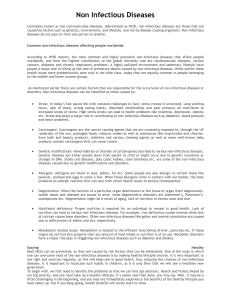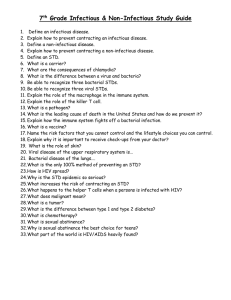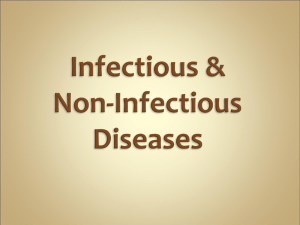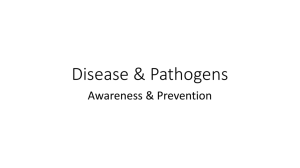ppt_ch24_e_Non_infectious diseases and dis_prevention
advertisement
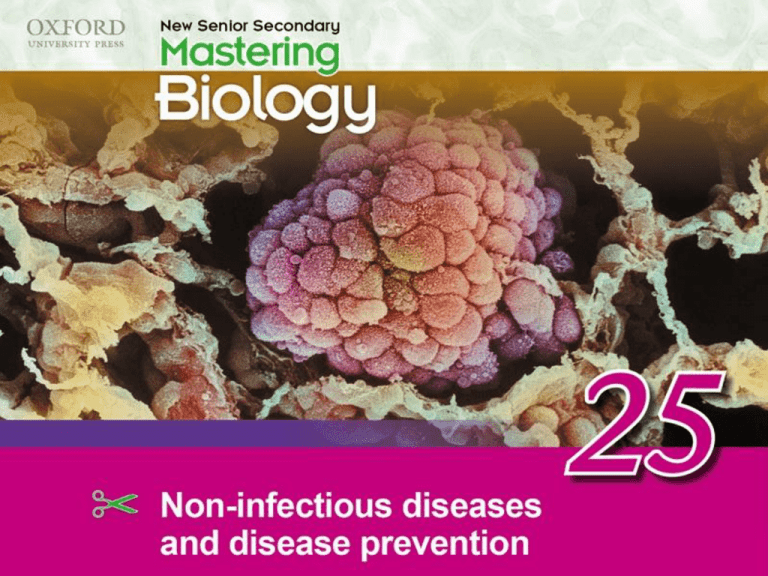
1 Think about… 25.1 Non-infectious diseases 25.2 Prevention of diseases Recall ‘Think about…’ Summary concept map 2 Cancer is the leading cause of death. malignant tumour in air sac 3 There has been an increase of over 25% in the number of deaths from cancer during the past 10 years. 4 25.1 Non-infectious diseases • cannot be transmitted from person to person • account for about 60% of deaths and disabilities • many develop slowly chronic diseases (慢性病) • associate with risk factors (高危因素) 5 Risk factors A risk factor (高危因素) is anything that may increase the risk of developing a disease. There are four types of risk factors: 6 25.1 Non-infectious diseases 1 Biological risk factors e.g. age, sex, race • nasopharyngeal cancer (鼻咽癌) is more common in Chinese 7 25.1 Non-infectious diseases 2 Genetic risk factors e.g. family history • people with family history of diabetes mellitus have a higher risk of the disease 8 25.1 Non-infectious diseases 3 Environmental risk factors e.g. sunlight, air pollution, radiation • long exposure to sunlight increases the risk of skin cancer 9 25.1 Non-infectious diseases 4 Behavioural risk factors e.g. smoking, insufficient exercise • smokers have a higher risk of lung cancer 10 25.1 Non-infectious diseases Allergies • an overreaction of the immune system to foreign substances allergens (過敏原) e.g. dust mites (塵蟎) pollen 11 25.1 Non-infectious diseases Allergies • an overreaction of the immune system to foreign substances allergens (過敏原) e.g. animal hair insect stings 12 25.1 Non-infectious diseases Allergies • an overreaction of the immune system to foreign substances allergens (過敏原) e.g. eggs & peanuts medicines 13 25.1 Non-infectious diseases Allergies • mild symptoms: running nose, sneezing, ithciness or a skin rash (疹) 14 25.1 Non-infectious diseases Allergies • severe symptoms: swelling of lips, tongue or throat, shortness of breath or loss of consciousness • often inherited (遺傳) 15 25.1 Non-infectious diseases Allergies Prevention • avoid the allergen 1 People with food allergy should read carefully any label and warning on prepacked food 16 25.1 Non-infectious diseases Allergies Prevention • avoid the allergen 2 People with asthma (哮喘) should avoid contact with dust mites 17 Cancer 18 Cancers of the human body 19 Major causes of cancer deaths Males Females 1 Lung cancer 1 Lung cancer 2 Liver cancer 2 Colon cancer & rectal cancer 20 Major causes of cancer deaths Males Females 3 Colon cancer & 3 Breast cancer rectal cancer 4 Stomach cancer 4 Liver cancer 21 Major causes of cancer deaths Males Females 5 Prostate cancer 5 Stomach cancer (前列線癌) 22 1 What is cancer 23 2 Why are there differences in cancer occurrence in males and females 24 3 Can cancer be prevented How 25 25.1 Non-infectious diseases Cancer changes in DNA uncontrolled cell division tumour (benign or malignant) 26 Cancer as loss of growth control 27 Benign vs Malignant tumour Benign tumour cells growth and spread unrestrained Malignant tumour --cancer 28 25.1 Non-infectious diseases Cancer • benign tumour (良性腫瘤): - tumour cells surrounded by a fibrous capsule - tumour cells do not spread to other tissues a benign tumour of fatty tissue 29 25.1 Non-infectious diseases Cancer • malignant tumour (惡性腫瘤): - also called cancer - tumour cells can spread through the bloodstream and lymphatic system - at new sites, tumour cells continue to divide uncontrollably damage the tissues 30 Invasion and metatasis Malignant tumors are tumors that are capable of spreading by invasion and metastasis 31 Metatasis a melanoma (a cancer of pigmented cells) arising in the skin can have cells that enter the bloodstream and spread to distant organs such as the liver or brain. Cancer cells in the liver would be called metastatic melanoma, not liver cancer. 32 25.1 Non-infectious diseases Cancer 1 A cell begins to divide more often than normal. cell with changes in DNA 33 25.1 Non-infectious diseases Cancer 2 One of the tumour cells has further tendency to divide. tumour (腫瘤) cell with further changes in DNA 34 25.1 Non-infectious diseases Cancer 3 The malignant tumour develops its own blood vessels. cancer cells blood vessel 35 25.1 Non-infectious diseases Cancer 3 The tumour cells (cancer cells) travel through the blood to invade other tissues. cancer cells blood vessel 36 Characteristic of cancer cells I Suggest how cancer cells appear under microscope? 37 Characteristic of cancer cells II a large number of dividing cells, variation in nuclear size and shape, loss of specialized cell features, loss of normal tissue organization, a poorly defined tumor boundary. 38 Diagnosis- Pap smear and biopsy 39 Colorectal Cancer Staging Staging is the process of determining how far a tumor has spread beyond its original location. Staging may not be related to the size of the tumor. Treatment decisions also depend upon the stage of a tumor. Staging for colorectal cancer is as follows: Stage 0 – The cancer is found only in the innermost lining of the rectum or colon. Stage I – The cancer has not spread beyond the inner wall of the rectum or colon. Stage II – The cancer has spread into the muscle layer of the rectum or colon. Stage III – The cancer has spread to at least one lymph node in the area. Stage IV – The cancer has spread to distant sites in the body, such as the bones, liver, or lungs. This stage is NOT dependent on how far the tumor has penetrated or if the cancer has spread to lymph nodes near the tumor. 40 Screening for Colorectal Cancer It is recommended that most people have a screening colonoscopy every year starting at age 50. A colonoscopy allows examination of the entire colon and rectum using a tiny camera. This test can find cancers in the early, most treatable stage and actually prevent cancers from developing by removing polyps, as shown here. 41 Factors that can lead to cancer 42 Clues from geographic distribution of cancer incidents 43 Risk factors: UV, X-ray, tobacco 44 Risk factor: some viral infections 45 Risk factor_age Because cancer usually requires a number of mutations, the chances of developing cancer increase as a person gets older because more time has been available for mutations to accumulate. 46 Cancer abnormal function of the genes 47 25.1 Non-infectious diseases Cancer • agents that can induce changes in DNA and make cells cancerous carcinogens (致癌物) symbol of carcinogens 48 25.1 Non-infectious diseases Cancer Chemical Carcinogen Tar in cigarette smoke Linked to Lung cancer Nitrosamine (亞硝胺) in salted fish Nasopharyngeal cancer Asbestos (石棉) in construction materials Throat cancer, lung cancer 49 25.1 Non-infectious diseases Cancer Radiation Carcinogen Linked to Ultraviolet light (紫外光) Skin cancer in sunlight X-ray in medical examination Blood cancer, thyroid cancer (甲狀腺癌) 50 25.1 Non-infectious diseases Cancer Virus Carcinogen Linked to Human Papillomavirus Cervical cancer (HPV) (人類乳頭瘤病毒) (子宮頸癌) Hepatitis B virus Liver cancer 51 Carcinogens _UV light causes Thymine-dimer formation 52 Carcinogens _nitrous acid Chemical mutagens such as nitrous acid (HNO2) may cause nucleotide deamination: conversion of an amino group to a keto group. Thus a transition mutation occurs: e.g. adenine are converted to hypoxanthine (which base pairs with cytosine). 53 Chemical mutagens such as nitrous acid (HNO2) may cause nucleotide deamination: conversion of an amino group to a keto group. adenine are converted to hypoxanthine (which base pairs with cytosine), respectively. 54 Carcinogens _base analogues 5-Bromo-uracil can substitute for T, and then wind up binding with G (rather than A), thus inducing a TRANSITION (G->A) mutation. 55 High energy radiation induces mutation: High energy radiations cause damages to DNA Ionizing radiation causes the formation of ions and free radicals that react with DNA; base substitutions or breakage of the sugar-phosphate backbone result. Ultraviolet radiation is non-ionizing; it causes bonding between adjacent thymines. DNA repair Damage to DNA caused by ultraviolet radiation can be repaired by enzymes that cut out and replace the damaged portion of DNA. 56 DNA damage vs DNA repair 57 25.1 Non-infectious diseases Cancer • caused by an accumulation of changes in DNA that controls cell division more common in people who are repeatedly exposed to carcinogens or in older people • changes in DNA can be inherited 58 Cancer prevention 59 25.1 Non-infectious diseases Cancer Prevention • reduce the exposure to carcinogens 1 Wear masks and gloves when handling construction materials with asbestos 60 25.1 Non-infectious diseases Cancer Prevention • reduce the exposure to carcinogens 2 Wear sun protection to reduce exposure to ultraviolet light 61 25.1 Non-infectious diseases Cancer Prevention • reduce the exposure to carcinogens 3 Avoid early sex and multiple sex partners to reduce the risk of HPV infection HPV 62 25.1 Non-infectious diseases Cancer Prevention • adopt a healthy lifestyle 1 Do not smoke the risk of developing lung cancer is much lower 63 25.1 Non-infectious diseases Cancer annual mortality rate per 1000 men Prevention 64 years after giving up smoking 65 25.1 Non-infectious diseases Cancer Prevention • adopt a healthy lifestyle 2 Include more vegetables in the diet - dietary fibre increases the bulk of faeces speeds up the passage of carcinogens through the intestine 66 25.1 Non-infectious diseases Cancer Prevention • adopt a healthy lifestyle 2 Include more vegetables in the diet the risk of developing colon cancer is lower 67 Well-done red meat linked to aggressive prostate cancer 68 2. What do you consider as processed meat? (WHO) Processed meat refers to meat that has been transformed through salting, curing, fermentation, smoking, or other processes to enhance flavour or improve preservation. Examples of processed meat include hot dogs (frankfurters), ham, sausages, corned beef, and biltong or beef jerky as well as canned meat and meat-based preparations and sauces. 69 1. What do you consider as red meat? Red meat refers to all mammalian muscle meat, including, beef, veal, pork, lamb, mutton, horse, and goat. (WHO) 70 25.1 Non-infectious diseases Cancer mortality from colon cancer (per 100 000 persons) Prevention 71 daily intake of dietary fibre (g) 10. What types of cancers are linked or associated with eating red meat? The strongest, but still limited, evidence for an association with eating red meat is for colorectal cancer. There is also evidence of links with pancreatic cancer and prostate cancer. 11. What types of cancers are linked or associated with eating processed meat? The WHO Working Group concluded that eating processed meat causes colorectal cancer. An association with stomach cancer was also seen, but the evidence is not conclusive. 72 Avoiding carcinogens can reduce the risk of cancer • Lifestyle choices can help reduce cancer risk 73 Carcinogens in the workplace 74 Diagnosis of cancer_ colon cancer by DNA analysis 75 Diagnosis of cancer_mammogram low dose X-ray of the breast, which can pick up very small breast cancer. 76 25.1 Non-infectious diseases Cardiovascular diseases • involve the heart and/or the blood vessels e.g. coronary heart disease (冠心病), stroke (中風), high blood pressure 77 25.1 Non-infectious diseases Cardiovascular diseases Coronary heart disease • coronary arteries supply food and oxygen to cardiac muscles continuously 3D animation coronary artery 78 25.1 Non-infectious diseases Cardiovascular diseases Coronary heart disease smooth lining blood flow unrestricted 79 25.1 Non-infectious diseases Cardiovascular diseases Coronary heart disease blood flow slowed down cholesterol plaque 80 25.1 Non-infectious diseases Cardiovascular diseases Coronary heart disease artery blocked by a blood clot (a heart attack results) 81 25.1 Non-infectious diseases Cardiovascular diseases Heart attack • great pain in the chest • the heart may even stop beating death 82 25.1 Non-infectious diseases Cardiovascular diseases Stroke • blockage occurs in arteries carrying blood to the brain • brain cells die within minutes without oxygen supply paralysis (癱瘓) death 83 25.1 Non-infectious diseases Cardiovascular diseases High blood pressure • causes: 1 the heart pumps blood with excessive forces 2 the arterioles are narrowed, so that blood exerts greater forces on the walls 84 25.1 Non-infectious diseases Cardiovascular diseases High blood pressure • damages the inner walls of arteries • increases the risk of coronary heart disease, heart attack and stroke 85 25.1 Non-infectious diseases Cardiovascular diseases High blood pressure Risk factors: • high blood cholesterol • smoking • aging • family history 86 25.1 Non-infectious diseases Cardiovascular diseases High blood pressure Risk factors: • obesity • diabetes mellitus • stress • insufficient exercise • alcohol use 87 25.1 Non-infectious diseases Cardiovascular diseases Prevention 1 Avoid eating too much cholesterol and lipids egg yolk internal organs seafood 88 25.1 Non-infectious diseases Cardiovascular diseases Prevention 1 Avoid eating too much cholesterol and lipids - trans fat (反式脂肪) and certain vegetable oils increase blood cholesterol level foods high in trans fat 89 25.1 Non-infectious diseases Cardiovascular diseases Prevention 2 Stop smoking - nicotine causes constriction of blood vessels blood pressure rises the heart has to work harder 90 25.1 Non-infectious diseases Cardiovascular diseases Prevention 2 Stop smoking - nicotine increases stickiness of blood platelets and formation of blood clots - carbon monoxide causes damage to the inner walls of arteries 91 25.1 Non-infectious diseases Cardiovascular diseases Prevention 3 Have balanced diets 92 25.1 Non-infectious diseases Cardiovascular diseases Prevention 4 Do exercise regularly 93 25.1 Non-infectious diseases Diabetes mellitus • the pancreas does not produce enough insulin or the body cells cannot respond to the insulin produced highly variable blood glucose level severe damage to blood vessels of the heart, kidneys, eyes and nerves 94 25.1 Non-infectious diseases Diabetes mellitus • two forms: Type 1 diabetes Type 2 diabetes 95 25.1 Non-infectious diseases Diabetes mellitus • Prevalence rate (流行率) Type 1 diabetes 5–10% Type 2 diabetes 90–95% 96 25.1 Non-infectious diseases Diabetes mellitus • Cause Type 1 diabetes Type 2 diabetes Little or no insulin is Body cells are produced because insensitive to the secreting cells insulin are destroyed 97 25.1 Non-infectious diseases Diabetes mellitus • Risk factor Type 1 diabetes Family history Type 2 diabetes Family history Aging Obesity Insufficient exercise 98 25.1 Non-infectious diseases Diabetes mellitus • Risk group Type 1 diabetes Children and young adults Type 2 diabetes Adults and obese children 99 25.1 Non-infectious diseases Diabetes mellitus • Symptoms Type 1 diabetes Type 2 diabetes Excessive urine production, constant thirst and hunger, weight loss, fatigue and blurred vision 100 25.1 Non-infectious diseases Diabetes mellitus • Management and control Type 1 diabetes Blood glucose monitoring Regular injections of insulin Healthy eating Exercise Type 2 diabetes Blood glucose monitoring Healthy eating Exercise 101 25.1 Non-infectious diseases Diabetes mellitus Type 1 diabetes Type 2 diabetes Insulin-dependent Non-insulindependent diabetes diabetes 102 25.1 Non-infectious diseases Diabetes mellitus insulin injection 103 25.1 Non-infectious diseases Diabetes mellitus • Prevention Type 1 diabetes No prevention Type 2 diabetes Eat a healthy and high fibre diet Exercise regularly Control the body weight 104 25.1 Non-infectious diseases 1a A risk factor is anything that may increase the risk of developing a disease. 105 25.1 Non-infectious diseases 1b There are four types of risk factors: biological , genetic environmental and behavioural risk factors. 106 25.1 Non-infectious diseases 2a Allergy (overreaction of the immune system to allergens) Risk factors: family history and exposure to allergens 107 25.1 Non-infectious diseases 2a Allergy (overreaction of the immune system to allergens) Prevention: avoid exposure to allergens - read food label carefully - avoid contact with dust mites 108 25.1 Non-infectious diseases 2b Cancer (malignant cell growth) Risk factors: aging , race, family history, exposure to carcinogens and smoking 109 25.1 Non-infectious diseases 2b Cancer (malignant cell growth) Prevention: reduce exposure to carcinogens and adopt healthy lifestyles - wear masks and gloves when handling construction materials with asbestos 110 25.1 Non-infectious diseases 2b Cancer (malignant cell growth) Prevention: reduce exposure to carcinogens and adopt healthy lifestyles - wear sun protection - avoid early sex and multiple sex partners 111 25.1 Non-infectious diseases 2b Cancer (malignant cell growth) Prevention: reduce exposure to carcinogens and adopt healthy lifestyles - do not smoke and avoid passive smoking 112 25.1 Non-infectious diseases 2b Cancer (malignant cell growth) Prevention: reduce exposure to carcinogens and adopt healthy lifestyles - include more vegetables in the diets 113 25.1 Non-infectious diseases 2c Cardiovascular diseases Risk factors: aging, family history, high blood cholesterol , obesity, diabetes mellitus, stress, insufficient exercise , smoking and alcohol use 114 25.1 Non-infectious diseases 2c Cardiovascular diseases Prevention: - have balanced diets - exercise regularly - control the body weight - do not smoke nor drink wine 115 25.1 Non-infectious diseases 2d Diabetes mellitus Risk factors (type 1 diabetes): family history Risk factors (type 2 diabetes): family history, aging, obesity , insufficient exercise 116 25.1 Non-infectious diseases 2d Diabetes mellitus Prevention (type 2 diabetes): - have balanced diets - exercise regularly - control the body weight 117 25.2 Prevention of diseases • increasing use of air travel helps spread infectious diseases rapidly 118 25.2 Prevention of diseases • unhealthy lifestyles are related to the growing incidence of non-infectious diseases 119 25.2 Prevention of diseases • different goals: 1 To stop diseases from occurring 2 To detect and treat diseases at an early stage, before any symptom or functional loss occurs 120 25.2 Prevention of diseases • achieve the goals by: 1 offering immunization programmes 2 promoting healthy lifestyles 3 promoting community health 121 25.2 Prevention of diseases Immunization programmes • the process of inducing immunity (免疫性) to a disease in the body e.g. via a vaccine (疫苗) contains a weakened or dead pathogen or a part of pathogen 122 25.2 Prevention of diseases Immunization programmes oral form injection 123 25.2 Prevention of diseases Immunization programmes • based on local disease prevalence, children in HK are offered free vaccines 124 25.2 Prevention of diseases Immunization programmes • if the majority of people are immunized, infectious diseases will not be spread easily health and lives of individuals and the community are protected 125 25.2 Prevention of diseases Healthy lifestyles • adopting healthy lifestyles can help: - remove sources of infection - break the transmission link - prevent risk factors 126 25.2 Prevention of diseases Healthy lifestyles • examples: - have balanced diets - exercise regularly - get enough rest - maintain good personal hygiene - do not smoke and do not abuse alcohol or drugs 127 25.2 Prevention of diseases Community health • focuses on the protection and improvement of health of the whole community rather than individuals • involves prevention and early detection of diseases through: screening for infections or diseases disease surveillance promotion of health education 128 25.2 Prevention of diseases Community health 1 Screening for infections or diseases • testing the whole population for the presence or absence of an infection or a disease e.g. Cervical Screening Programme (子宮頸普查計劃) 129 25.2 Prevention of diseases Community health 1 Screening for infections or diseases • early diagnosis improves cure rate helps save health resources by treating diseases before they progress 130 25.2 Prevention of diseases Community health 2 Disease surveillance (疾病監察) • involves the identification of current incidence and trends of diseases • helps the health authority to: - carry out timely investigation - develop effective strategies for controlling the diseases 131 25.2 Prevention of diseases Community health 3 Promotion of health education • educates the public about: - the benefits of adopting healthy lifestyles and preventive measures - receiving early treatment when required 132 25.2 Prevention of diseases Community health • protection and maintenance of health is both an individual and public responsibility 133 25.2 Prevention of diseases 1 Immunization is the process of inducing immunity to a disease in the body. Immunization can be done by vaccination . 134 25.2 Prevention of diseases 2 If the majority of people are immunized, infectious diseases will not be spread easily in the community. The health and lives of individuals and the community are protected. 135 25.2 Prevention of diseases 3 Examples of healthy lifestyles: a Have balanced diets b Exercise regularly c Get enough rest 136 25.2 Prevention of diseases 3 Examples of healthy lifestyles: d Maintain good personal hygiene e Do not smoke and do not abuse alcohol or drugs 137 25.2 Prevention of diseases 4 Community health is the protection and improvement of health of the whole community . 138 25.2 Prevention of diseases 5 Major activities involved in community health: a Screening for infections or diseases b Disease surveillance c Promotion of health education 139 1 What is cancer? Cancer is a malignant tumour resulted from uncontrolled cell division. The tumour cells can spread through the bloodstream and the lymphatic system to invade other tissues. 140 2 Why are there differences in cancer occurrence in males and females? The differences in cancer occurrence may be related to the differences in genetic material and behaviour in males and females. 141 3 Can cancer be prevented? Cancer can be prevented. Some preventive measures are: • For throat and lung cancer: wear masks and gloves when handling construction materials with asbestos. 142 3 Can cancer be prevented? Cancer can be prevented. Some preventive measures are: • For skin cancer: wear sun protection. 143 3 Can cancer be prevented? Cancer can be prevented. Some preventive measures are: • For cervical cancer: avoid early sex and multiple sex partners; have screening tests for early cellular changes in cervix; 144 3 Can cancer be prevented? Cancer can be prevented. Some preventive measures are: • For cervical cancer: injection of Human Papillomavirus vaccines. 145 3 Can cancer be prevented? Cancer can be prevented. Some preventive measures are: • For colon cancer: include more vegetables in the diets. 146 Diseases can be infectious non-infectious prevented by immunization programmes community health healthy lifestyle 147 non-infectious examples include allergies cancer diabetes mellitus cardiovascular diseases 148 diabetes mellitus two types type 1 diabetes type 2 diabetes 149
